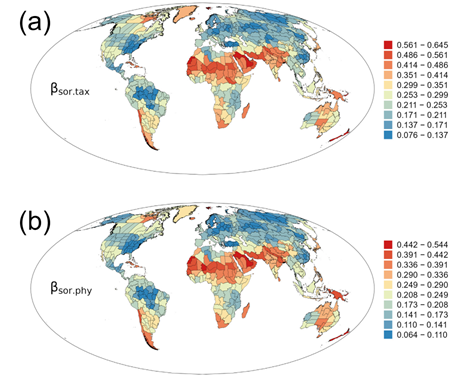Scientists present the first set of global maps showing geographic patterns of beta-diversity in flowering plants
Published 18 October, 2023
Beta-diversity serves as a crucial metric for gauging shifts in species composition over spatial or temporal scales, bridging the spectrum between localized (alpha) and broader regional (gamma) diversity. In the fields of ecology, biogeography and conservation biology, to elucidate the origins and sustenance of geographic beta-diversity patterns, we need to explore both the taxonomic and phylogenetic beta-diversity at different evolutionary depths.
In an article published in the KeAi journal Plant Diversity, using a comprehensive database of plant distributions worldwide, Dr. Hong Qian of Illinois State Museum in the US and Dr. Shenhua Qian of Chongqing University in China explored and mapped geographic patterns of beta-diversity for flowering plant (angiosperm) genera in regional floras across the world.
They analyzed both taxonomic and phylogenetic beta-diversity, including their constituent elements. Moreover, they considered both tip-weighted and basal-weighted phylogenetic beta-diversity in relation to latitude.
Consequently, they showed that the global distribution of beta-diversity is highly heterogeneous. This is the case for taxonomic and phylogenetic beta-diversity, as well as for both tip-weighted and basal-weighted phylogenetic beta-diversity. They also showed that there are highly consistent geographic patterns among different metrics of beta-diversity. In most cases, metrics of beta-diversity are negatively associated with latitude, particularly in the Northern Hemisphere.
Notably, different metrics of taxonomic beta-diversity are strongly and positively correlated with their counterparts of phylogenetic beta-diversity.
“It is well known that regions characterized by wet tropical climates tend to exhibit elevated levels of alpha- and gamma-diversity in both plant and animal species,” says Qian. “However, one of the interesting patterns that we found in this study is that regions of high beta-diversity are located in dry rather than wet tropical climates. For example, the Sahara Desert has the highest beta-diversity of flowering plants.”

Contact author name, affiliation, email address: Danai Ioanna Koukoumaki, Research and Collections Center, Illinois State Museum, 1011 East Ash Street, Springfield, IL 62703, USA, hong.qian@illinoisstatemuseum.org
Conflict of interest: The authors declare that they have no known competing financial interests or personal relationships that could have appeared to influence the work reported in this paper.
See the article: H. Qian, et al. Geographic patterns of taxonomic and phylogenetic β-diversity of angiosperm genera in regional floras across the world, Plant Diversity (2023), doi: https://doi.org/10.1016/j.pld.2023.07.008